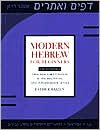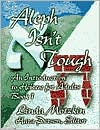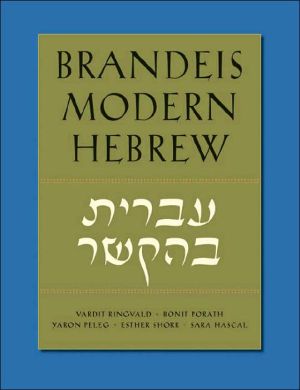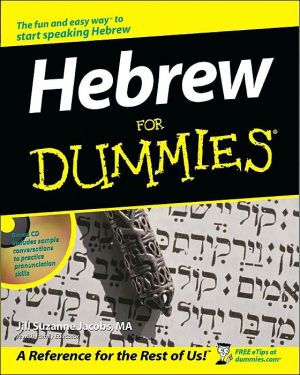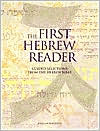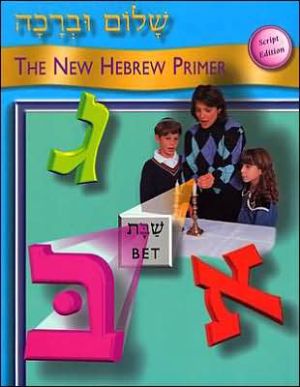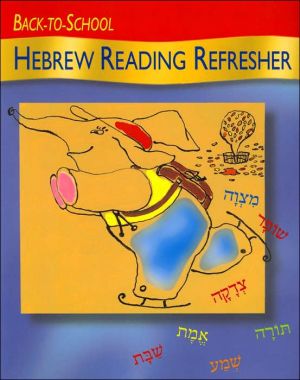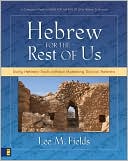Modern Hebrew for Beginners: A Multimedia Program for Students at the Beginning and Intermediate Levels
Modern Hebrew for Beginners offers high school, college, and independent-study students a state-of-the-art learning experience. This combination text- and workbook is designed to be used with web-based audio, visual, and interactive materials to give students multiple learning opportunities suited to a variety of learning styles. This allows intense practice of all four language skills: reading, writing, listening comprehension, and conversation.\ Esther Raizen introduces the basic concepts...
Search in google:
Modern Hebrew for Beginners offers high school, college, and independent-study students a state-of-the-art learning experience. This combination text- and workbook is designed to be used with web-based audio, visual, and interactive materials to give students multiple learning opportunities suited to a variety of learning styles. This allows intense practice of all four language skills: reading, writing, listening comprehension, and conversation.Esther Raizen introduces the basic concepts of Hebrew through a wide variety of written and oral exercises in this text, many of which link to the website's computer tutorials and short original films based on contemporary Israeli life and society. She emphasizes the spoken language, while also paying attention to various aspects of normative grammar, of the written language, and of cultural elements associated with Hebrew. With this variety of materials and the capacity for continuous updating via the website, teachers and students will find this book endlessly adaptable and highly suitable for self-paced training.
To the User Notes on the Hebrew Writing System and Pronunciation 0.1 The Hebrew writing system--consonants 0.2 Hebrew vowels 0.3 A note on transliteration and borrowed words Unit álef Greetings Names Students in school 1.1 The conjunction [] and 1.2 Sentence structure: The simple sentence 1.3 Gender and number 1.4 The definite article []Unit bet More greetings Studying Subject pronouns School and work "want," "be able," "need" 2.1 Sentence structure: Yes/no questions and negation 2.2 Sentence structure: Coordinate sentences 2.3 Verb forms: Present tense and the infinitive 2.4 Vowel changes with [] 2.5 Gender: Masculine as the common designation 2.6 Pronouns referring to inanimate nouns 2.7 Repetition of prepositions 2.8 The modal verbs [] can and [] need 2.9 Information questions: Sentence structure Unit gímel Where we live Introducing people Places in Israel 3.1 The preposition [] from 3.2 Markers of gender and number 3.3 Stress shift and vowel change 3.4 The demonstrative pronounsUnit délet Time expressions and tenses 4.1 The root 4.2 Final -heh verbs 4.3 Short verbs 4.4 Adverbs Unit heh Seasons The days of the week Telling time Writing 5.1 Definiteness 5.2 The preposition [] 5.3 Location and movement 5.4 The use of because 5.5 Sentence structure: Reversal of subject and verb in questions 5.6 Vowels and consonants: Compensatory lengthening 5.7 The verb [] to know Unit vav Shopping Food and eating 6.1 Nouns of large quantity used in the singular form 6.2 The adjective [] much 6.3 Either-or, neither-nor 6.4 A typical vowel change 6.5 Adjectives 6.6 Negating an adjective 6.7 "There is" and "there is not" 6.8 Sentence structure: Objects fronted for emphasis Unit záyin The weather 7.1 Prepositions 7.2 The absence of "it" as a "dummy pronoun" in Hebrew 7.3 The subordinating particle [] 7.4 On the pronunciation of the word [] 7.5 More about definiteness 7.6 Predicative adjectives and definitenessUnit chet Professions and areas of study 8.1 More on information questions 8.2 [] and [] as when 8.3 Third person pronouns as linking elements 8.4 [] in the past tense 8.5 Vocal, composite, and silent schwas Unit tet Clothing 9.1 Compound nouns and patterns of change in nouns 9.2 Adjectives: Agreement in definiteness (review) 9.3 The direct object 9.4 [], the marker of a definite direct object 9.5 Common errors with []: Omission and over-generalization 9.6 Questions about objects of prepositionsUnit yod Addresses The family Counting The calendar and birthdays 10.1 Numbers 10.2 Ordinal numbers 10.3 Cardinal numbers 10.4 Stative verbs 10.5 More on telling time Unit yod-álef The body Directions 11.1 Structures imparting possession 11.2 The construct state--[]--as a structure indicating possession 11.3 [] as a marker pointing to a directionEnglish/Hebrew glossary Hebrew/English glossary
